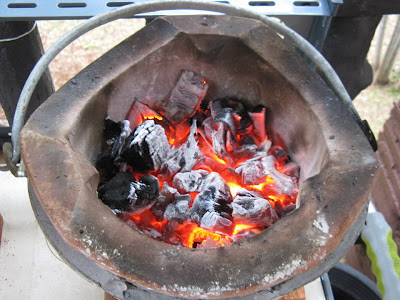While I am doing the very simple running stitch on my fabric bag, I became more and more interested in how running stitch could make the fabric surface more interesting. This one with a mixture of colors and motifs on a quilted cushion by Anna Maria Horner is very pretty.
ตอนเย็บกระเป๋าผ้าฉันรู้สึกอยากรู้ว่าคนอื่นเขาทำอย่างไรกับการเนาแบบง่ายๆอย่างนี้ให้ดูมีพื้นผิวที่น่าสนใจยิ่งขึ้น พอได้มาเห็นงานปลอกหมอนปักควิ้ลท์ชิ้นนี้ของแอนนามาเรียฮอร์เนอร์แล้วรู้สึกว่าเป็นวิธีการตอบโจทก์ที่น่ารักน่าเอ็นดูด้วยการสร้างลายที่แตกต่างและการเล่นสี
My bag is not a quilted bag. It doesn’t have a filling in between the outer fabric and the lining. I just use two pieces of heavy cotton. However, the thickness and weight are sufficient to create a wavy texture that I wish. But quilting would be nice also. Here is a video on how you can quilt using the thimble and round frame as tools. It gives a better effect than machine quilting.
 |
| Anna has is a textile designer. Here is a link to her blog แอนนาเป็นนักออกแบบลายผ้า มีบล็อกอยู่ที่ลิ้งค์นี้ |
My bag is not a quilted bag. It doesn’t have a filling in between the outer fabric and the lining. I just use two pieces of heavy cotton. However, the thickness and weight are sufficient to create a wavy texture that I wish. But quilting would be nice also. Here is a video on how you can quilt using the thimble and round frame as tools. It gives a better effect than machine quilting.
ฉันไม่ได้ทำกระเป๋าควิ้ลท์เพราะไม่ได้สอดใส้ระหว่างผ้าสองชิ้น แค่ใช้ผ้าฝ้ายหนาๆมาประกบกันเพียงแค่นี้แต่ความหนาและน้ำหนักผ้าก็เพียงพอสำหรับการสร้างรอยคลื่นบนผืนผ้าตามเจตนา ข้างล่างเป็นวิดีโอวิธีการเย็บควิ้ลท์ที่ขึงบนสะดึงด้วยมือโดยมีปลอกสวมนิ้วกันเจ็บ งานควิ้ลท์ที่เย็บด้วยมือจะดูดีกว่างานที่ทำด้วยจักรเย็บผ้า
Two years ago we visited Michel’s cousin, Micky who lives in Verfeuil, a region of Languedoc (South-Western France). She gave me this sample of quilting by the boutis method.
เมื่อสองปีก่อนเราไปเที่ยวบ้านลูกพี่ลูกน้องของมิเชลที่แวร์เฟอย์ในแคว้นล็องก์ด็อค(ทิศตะวันตกเฉียงใต้ของฝรั่งเศส) “บูตี”ชิ้นนี้ที่เธอทำเองเป็นของที่ระลึกให้กับเรา
The surface pattern from boutis actually comes from stuffing the soft cotton rope in between the two pieces of fabrics. The stitches are small so that the rope does not fall off. There are needles to help to compact the ropes between the 2 pieces of fabrics. It is time consuming and quite complicated. But what a pleasure!
 |
Fine running stitch. เนาแบบละเอียดมาก |
ลายนูนต่ำของการเย็บแบบบูตีเกิดขึ้นได้ด้วยการเย็บลวดลายแล้วเอาเชือกสอดเข้าไปในลวดลายระหว่างผ้าสองชิ้น แล้วใช้เข็มไซส์ต่างๆช่วยดันจากทุกซอกทุกมุมให้เชือกเข้าไปอัดจนแน่น เป็นวิธีที่ใช้เวลามากแต่ดูน่าสนุก
 |
| Tools อุปกรณ์ “Boutis de Ville- Boutis des Champs” by Francine Nicolle |
 |
| Motifs ลาย“Boutis de Ville- Boutis des Champs” by Francine Nicolle |
 |
| “Boutis de Ville- Boutis des Champs” by Francine Nicolle |
 |
| Boutis Needles เข็มบูตี “Boutis de Ville- Boutis des Champs” by Francine Nicolle |
 |
| “Boutis de Ville- Boutis des Champs” by Francine Nicolle |
This book, “Boutis de Ville- Boutis des Champs” by Francine Nicolle is a lovely introduction to this traditional needlework of France. It also reminds me a lot of what Christian Lacroix used to do for his Couture work in the early 1990’s. Lacroix himself also came from South of France.
หนังสือ“Boutis de Ville- Boutis des Champs” โดย Francine Nicolle เป็นหนังสือแนะนำการเย็บบูตีซึ่งเป็นภูมิปัญญาพื้นบ้านของฝรั่งเศส เป็นเทคนิคที่ฉันเคยเห็นคริสเตียน ลาครัวซ์เอามาใช้ในช่วงต้นยุค 1990’s บ้านเกิดของลาครัวซ์ก็อยู่ตอนใต้ของฝรั่งเศสเช่นกัน
I picked up this other book in Paris a year later- Le Boutis by Marie-Noelle Bayard.
ปีต่อมาฉันไปคว้าเล่มนี้มาจากปารีส- Le Boutis by Marie-Noelle Bayard I have almost forgotten these books if I had not started thinking about hand stitching again.
เกือบลืมสองเล่มนี้แล้วถ้าไม่ได้กลับมาสนใจเรื่องงานเย็บมือ




















































